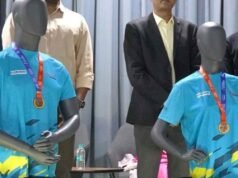2023 Nobel laureates Katalin Kariko of Hungary (L) and Drew Weissman of the US.
| Photo Credit: AFP/Jonathan Nackstrand
The story so far: The 2023 Nobel Prize in Physiology or Medicine has been awarded to Katalin Karikó and Drew Weissman for their research that enabled the development of mRNA vaccines against COVID-19. The prize was announced by The Royal Swedish Academy of Science on October 2, 2023.
Dr. Karikó and Dr. Weissman were awarded the prize for their “discoveries concerning nucleoside base modifications that enabled the development of effective mRNA vaccines against COVID-19”.
(For top health news of the day, subscribe to our newsletter Health Matters)
The first vaccines to use the mRNA technology were those made by Pfizer/BioNTech and Moderna against COVID-19.
What are mRNA vaccines?
mRNA stands for messenger RNA, is a form of nucleic acid which carries genetic information. Like other vaccines, the mRNA vaccine also attempts to activate the immune system to produce antibodies that help counter an infection from a live virus. However, while most vaccines use weakened or dead bacteria or viruses to evoke a response from the immune system, mRNA vaccines only introduce a piece of the genetic material that corresponds to a viral protein. This is usually a protein found on the membrane of the virus and is called spike protein. Therefore, the mRNA vaccine does not expose individuals to the virus itself.
According to an article by Thomas Schlake et al, in RNA BiologyRNA as a therapeutic was first promoted in 1989 after the development of a broadly applicable in vitro transfection technique. A couple of years later, mRNA was advocated as a vaccine platform. He says, “mRNA offers strong safety advantages. As the minimal genetic construct, it harbours only the elements directly required for expression of the encoded protein.”
The refinement of the mRNA platform owes everything to COVID. Rapid advancements within a remarkable period of one year allowed the technology to gain several revolutionary steps ahead, in order for it to be used successfully to drive vaccines that work.
A common approach by vaccine makers during the pandemic was to introduce a portion of the spike protein, the key part of the coronavirus, as part of a vaccine. Some makers, such as those that made the Oxford University vaccine (AstraZeneca) or Sputnik V, wrapped the gene that codes for the spike protein into an inactivated virus that affects chimpanzees, called the chimpanzee adenovirus. The aim is to have the body use its own machinery to make spike proteins from the given genetic code. The immune system, when it registers the spike protein, will create antibodies against it.
How are these vaccines different?
A piece of DNA must be converted into RNA for a cell to be able manufacture the spike protein. While an mRNA vaccine might look like a more direct approach to getting the cell to produce the necessary proteins, mRNA is very fragile and will be shred apart at room temperature or by the body’s enzymes when injected. To preserve its integrity, the mRNA needs to be wrapped in a layer of oily lipids, or fat cells. One way to think of this is that an mRNA-lipid unit most closely mimics how a virus presents itself to the body, except that it cannot replicate like one. DNA is much more stable and can be more flexibly integrated into a vaccine-vector. In terms of performance, both are expected to be as effective.
A challenge with mRNA vaccines is that they need to be frozen from -90 degree Celsius to -50 degree Celsius. They can be stored for up to two weeks in commercial freezers and need to be thawed at 2 degrees Celsius to 8 degrees Celsius at which they can remain for a month. A major advantage of mRNA and DNA vaccines is that because they only need the genetic code, it is possible to quickly update vaccines to emerging variants and even use them for a variety of diseases.
Viral vector vaccines, like Covishield, carry DNA wrapped in another virus, but mRNA are only a sheet of instructions to make spike proteins wrapped in a lipid (or a fat molecule) to keep it stable. In the case of COVID-19mRNA vaccines developed by Moderna, Pfizer and Pune-based Gennova Biopharmaceuticalsthese instructions alone are capable of producing the spike protein, which the immune system then uses to prepare a defence. The success of these vaccines has prompted researchers in India to use mRNA or other DNA-based methods for improvising vaccines to other deadly diseases.







